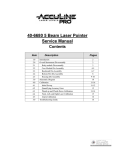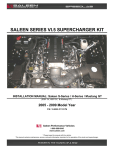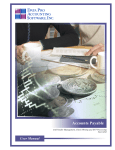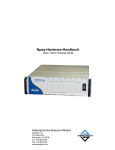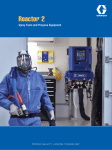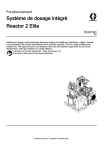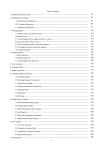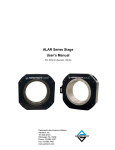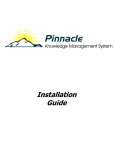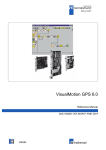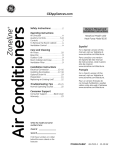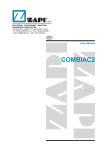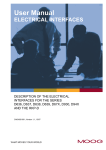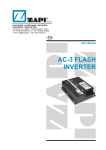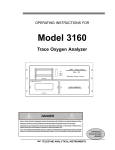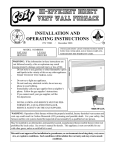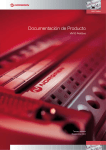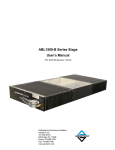Download AXR Series Stage User`s Manual
Transcript
AXR Series Stage Hardware Manual P/N: EDS168 (Revision 1.02.00) Dedicated to the Science of Motion Aerotech, Inc. 101 Zeta Drive, Pittsburgh, PA 15238-2897 Phone: +1-412-963-7470 Fax: +1-412-963-7459 www.aerotech.com Technical Support Go to www.aerotech.com/service-and-support.aspx for information and support about your Aerotech products. The website provides downloadable resources (such as up-to-date software, product manuals, and Help files), training schedules, and PC-to-PC remote technical support. You can also complete Product Return (RMA) forms and get information about repairs and spare or replacement parts. For immediate help, contact a service office or your sales representative. Have your customer order number available before you call or include it in your email. United States (World Headquarters) Phone: +1-412-967-6440 Fax: +1-412-967-6870 Email: [email protected] 101 Zeta Drive Pittsburgh, PA 15238-2897 www.aerotech.com United Kingdom Phone: +44 (0)1256 855055 Fax: +44 (0)1256 855649 Email: [email protected] Japan Phone: +81 (0)47 489 1741 Fax: +81 (0)47 489 1743 Email: [email protected] Germany Phone: +49 (0)911 967 9370 Fax: +49 (0)911 967 93720 Email: [email protected] China Phone: +86 (21) 3319 7715 Email: [email protected] France Phone: +33 1 64 93 58 67 Email: [email protected] Taiwan Phone: +886 (0)2 8751 6690 Email: [email protected] N O T E : Aerotech continually improves its product offerings; listed options may be superseded at any time. Refer to www.aerotech.com for the most up-to-date information. N O T E : All drawings and illustrations are for reference only and were complete and accurate as of this manual’s release. The most recent system drawings and schematics can be found on your software DVD or on www.aerotech.com. N O T E : Read this manual in its entirety before installing, operating, or servicing this product. If you do not understand the information contained herein, contact an Aerotech representative before proceeding. Strictly adhere to the statements given in this section and other handling, use, and operational information given throughout the manual to avoid injury to you and damage to the equipment. N O T E : This product is intended for light industrial manufacturing or laboratory use. This manual contains proprietary information and may not be reproduced, disclosed, or used in whole or in part without the express written permission of Aerotech, Inc. Product names mentioned herein are used for identification purposes only and may be trademarks of their respective companies. Copyright © 2010-2014 Aerotech, Inc. All rights reserved. AXR Hardware Manual Table of Contents Table of Contents Table of Contents List of Figures List of Tables iii iv v Chapter 1: Overview 1 1.1. Model Options 1.1.1. A Axis (Tilt) Drive Type Option 1.1.2. B Axis (Yaw) Mounting Location 1.1.3. Brake Option 1.1.4. Seal Option 1.1.5. Counterbalancing Kits 1.1.6. Manual Three Jaw Chuck 1.2. Dimensions 1.3. Safety Procedures and Warnings 1.4. EC Declaration of Incorporation Chapter 2: Installation 2.1. Unpacking and Handling the Stage 2.2. Preparing the Mounting Surface 2.3. Securing the Stage to the Mounting Surface 2.4. Attaching the Payload to the Stage 2.4.1. B Axis With Tabletop Option 2.4.2. B Axis With Manual Three Jaw Chuck 2.5. Electrical Installation Chapter 3: Operating Specifications 3.1. Environmental Specifications 3.2. Accuracy and Temperature Effects 3.3. Basic Specifications 3.4. Standard Motor Wiring 3.5. Limit Switches 3.6. Air Line Access 3.7. Brake Option 3.8. Drive Types 3.9. Counterbalance System 3.9.1. Offset Mounting Counterbalancing 3.9.2. Inline Mounting Counterbalancing 3.9.3. Balancing Charts 3.9.4. Balancing the A Axis Chapter 4: Maintenance 3 4 4 4 4 4 4 5 7 8 9 9 11 12 13 13 14 15 17 17 17 18 20 24 25 26 26 27 27 28 29 36 39 4.1. Service and Inspection Schedule 4.2. Cleaning and Lubrication 4.3. Troubleshooting 39 40 41 Appendix A: Warranty and Field Service 43 Appendix B: Revision History 45 Index 47 www.aerotech.com iii Table of Contents AXR Hardware Manual List of Figures Figure 1-1: Figure 1-2: Figure 2-1: Figure 2-2: Figure 2-3: Figure 2-4: Figure 3-1: Figure 3-2: Figure 3-3: Figure 3-4: Figure 3-5: Figure 3-6: Figure 3-7: Figure 3-8: Figure 3-9: Figure 3-10: Figure 3-11: Figure 3-12: Figure 3-13: Figure 3-14: Figure 3-15: Figure 3-16: Figure 3-17: iv AXR-100D Dimensions AXR-150 Dimensions AXR With Shipping Bracket Mounting Hole Locations Chuck Clamping Ranges Electrical Connectors and Grounds Limit Switch Wiring Air Line Access Brake Option: Air Line Access Adjustable Counterweight Locations (Offset and Chuck Options) Adjustable Counterweight Locations (-0E Option) AXR100D-100 Balance Chart AXR100D-0E Balance Chart AXR100D-100C Balance Chart AXR150D-125 Balance Chart AXR150D-125C Balance Chart AXR150D-0E Balance Chart AXR150G50-125 Balance Chart AXR150G100-125 Balance Chart AXR150G160-125 Balance Chart AXR150G50-125C Balance Chart AXR150G100-125C Balance Chart AXR150G160-125C Balance Chart 5 6 10 12 14 15 24 25 26 27 28 29 30 30 31 31 32 32 33 33 34 34 35 www.aerotech.com AXR Hardware Manual Table of Contents List of Tables Table 1-1: Table 2-1: Table 2-2: Table 3-1: Table 3-2: Table 3-3: Table 3-4: Table 3-5: Table 3-6: Table 3-7: Table 3-8: Table 3-9: Model Numbering System Stage to Mounting Surface Hardware Clamping Ranges for Self Centering Scroll Chucks Environmental Specifications AXR Series Specifications Motor Specifications Aerotech Motor and Feedback Cable Part Numbers Motor Pin Assignments for the A and B Axes Feedback Pin Assignments for the A Axis Feedback Pin Assignments for the B Axis Gear Drive Specifications Continuous Current and Torque Ratings www.aerotech.com 3 12 14 17 18 19 21 21 22 23 26 37 v Table of Contents vi AXR Hardware Manual www.aerotech.com AXR Hardware Manual Overview Chapter 1: Overview Aerotech’s AXR integrated two-axis rotary assembly provides high-speed machining capabilities for complex 3D part geometries. The precision-aligned system allows accurate positioning on a hemispherical surface. Multiple frame sizes with direct- or gear-driven options provide a wide range of load carrying capability. A Axis (Tilt) l l l l l l B Axis (Yaw) Multiple configurations support a range of load and accuracy requirements Integral rotary union for vacuum- or airactivated tooling High-speed yaw axis provides up to 1000 rpm High-load gear-drive or high-speed, direct-drive tilt-axis configurations Optional sealing protects the system from airborne particulates Brake available to limit stage motion in the unpowered state Direct-Drive Yaw Axis All AXR series rotary combinations feature a direct-drive yaw (B) axis. Direct-drive motors exhibit significantly higher throughput and maintenance-free operation when compared to gear- and screw-driven technology. With peak rotation speeds of up to 1000 rpm, the AXR is capable of supporting high-speed machining processes. A high-resolution encoder enables the axis to run at extremely slow speeds while maintaining excellent velocity regulation and positioning accuracy. High-Capacity Tilt Axis The AXR has both direct-drive and gear-driven tilt (A) axis configurations to meet the performance requirements of your specific application. The direct-drive version provides the highest possible operating speed and accuracy for demanding applications. A modular counterbalance system and different yaw mounting heights are available to balance offset loads. The tilt axis can be equipped with a brake to hold axis position when power is removed. For large load applications, the gear-drive units provide significantly higher continuous torque output while the drive mechanism limits motion in the power-off state. The precision antibacklash gearing enables this higher torque output while still maintaining excellent accuracy and repeatability performance. www.aerotech.com Chapter 1 1 Overview AXR Hardware Manual Material Handling The AXR comes standard with an integral rotary union that provides a single pneumatic control signal to the yaw-axis tabletop for customer supplied air- or vacuum-actuated tooling. The AXR can also be outfitted with a 3-jaw manual chuck for maximum part-holding flexibility. Scalable Product Solutions With both direct-drive and gear-driven platforms, various yaw table locations, a scalable counterbalance, standard pneumatic feed-through, and an optional 3-jaw chuck, the AXR can be configured to meet the requirements of most two-axis rotary assemblies. This chapter introduces standard and optional features of the AXR A/B combination stage and gives general safety precautions. The AXR is a two axis rotary assembly with pitch and yaw orientation. 2 Chapter 1 www.aerotech.com AXR Hardware Manual Overview 1.1. Model Options N O T E : Aerotech continually improves its product offerings; listed options may be superseded at any time. Refer to www.aerotech.com for the most up-to-date information. Table 1-1: Model Numbering System Stage Size -100D Direct-drive tilt (A) axis and yaw (B) axis rated for 15 kg maximum load -150D Direct-drive tilt (A) axis and yaw (B) axis rated for 30 kg maximum load -150G Gear-drive tilt (A) axis with direct-drive yaw (B) axis; rated for 30 kg maximum load Yaw Axis Configuration Yaw (B) axis tabletop height of AXR100D and AXR150x located at the center of rotation of the -0 tilt (A) axis; no counterweight attachment supported Yaw (B) axis tabletop height of AXR100D and AXR150D located at the center of rotation of the -0E tilt (A) axis; includes attachment features for counterweights to balance offset loads NOTE: 0E option not available on gear-driven AXRs (150G). Gearbox has sufficient holding torque to balance maximum moment load. Yaw (B) axis tabletop height for AXR100D is located 100 mm above the center of rotation of -100 the tilt (A) axis; includes attachment features for counterweights to balance offset loads Yaw (B) axis with 3-jaw 3.25-inch (82.6 mm) diameter manual scroll chuck; chuck jaws of -100C AXR100D are located 100 mm above the center of rotation of the tilt (A) axis; includes attachment features for counterweights to balance offset loads and 3-jaw manual chuck Yaw (B) axis tabletop height for AXR150x is located 125 mm above the center of rotation of -125 the tilt (A) axis; includes attachment features for counterweights to balance offset loads Yaw (B) axis with 3-jaw 5-inch (127 mm) diameter manual scroll chuck; chuck jaws of -125C AXR150x are located 125 mm above the center of rotation of the tilt (A) axis; includes attachment features for counterweights to balance offset loads and 3-jaw manual chuck Brake Configuration (Optional) -B Holding brake for tilt (A) axis; only available on 100D and 150D configurations Sealing Configuration (Optional) Seals on the tilt (A) and yaw (B) axes to prevent ingress of airborne particulates into the stage; -S the seal does not protect the AXR system from contact with fluids Counterweight Configuration (Optional) Counterweight kit for AXR100 (-100, -100C) for offset loads ranging from: -CCW1 -100: 23.5 N·m to 338 N·m -100c: 48 N·m to 242 N·m Counterweight kit for AXR100 (-100, -100C) for offset loads ranging from: -CCW2 -100: 1.4 N·m to 48 N·m -100c: 6 N·m to 36 N·m -CCW3 Counterweight kit for AXR100 (-100) for offset loads of 41.3 N·m -CCW4 Counterweight kit for AXR100 (-100C) for offset loads of 23.4 N·m -CCW5 Counterweight kit for AXR100 (-0E) for offset loads ranging from 10.8 N·m to 54.2 N·m -CCW6 Counterweight kit for AXR100 (-0E) for offset loads ranging from 31.1 N·m to 124.4 N·m -CCW7 Counterweight kit for AXR100 (-0E) for offset loads of 15.7 N·m -CCW8 Counterweight kit for AXR100 (-0E) for offset loads of 13.1 N·m (1) Offset loads include both the payload and stage unbalance. (2) A linear combination of counterweight kits can be employed to achieve balance. Refer to Section 3.9.3. determine if application falls within balance limits. www.aerotech.com Chapter 1 3 Overview AXR Hardware Manual 1.1.1. A Axis (Tilt) Drive Type Option The AXR has both direct drive and gear driven tilt (A) axis configurations. The direct drive version provides the highest possible operating speed and accuracy for demanding applications. For large load applications the gear drive units provide significantly higher continuous torque output while the drive mechanism limits motion in the power off state. The precision, anti-backlash gearing enables this higher torque output while still maintaining excellent accuracy and repeatability performance. Both the direct drive and gear drive versions of the A axis have the same footprint and mounting pattern, so a common design will interface with either stage. 1.1.2. B Axis (Yaw) Mounting Location Two different B-axis mounting locations are available to accommodate various payload sizes as well as workpiece holding. This option allows the B axis interface surface to be either inline with the A (tilt) axis of rotation or above the A axis of rotation. These orientations are referred to as "inline" and "offset" mounting, respectively, in the remainder of this manual. You can use the balancing charts in Section 3.9.3. to determine the merits of each mounting option. 1.1.3. Brake Option The direct drive Tilt axis can be equipped with a brake to hold the axis in position when power is removed. This option does not affect the footprint of the product. 1.1.4. Seal Option The AXR series stages are available with optional internal sealing to provide IP60 level dust protection. AXR stages are not rated for exposure to liquids. These seals are internal and do not require maintenance. 1.1.5. Counterbalancing Kits A modular counterbalance system is available to balance offset loads. These ktis are intended to balance the combined mass of the B axis stage and the customer payload about the axis of rotation of the A axis. N O T E : These kits are necessary for the direct drive Tilt axis and, to a lesser extent, the gear drive Tilt axis. 1.1.6. Manual Three Jaw Chuck The AXR can be outfitted with a three jaw manual chuck for maximum part holding flexibility. This option provides an payload interface offset at the same elevation as that of the standard tabletop. 4 Chapter 1 www.aerotech.com AXR Hardware Manual Overview 1.2. Dimensions N O T E : Aerotech continually improves its product offerings; listed options may be superseded at any time. Refer to www.aerotech.com for the most up-to-date information. CUSTOMER PNEUMATIC SUPPLY M5-0.8 THREAD (NOT AVAILABLE ON -100C) 4X 15 SLOTTED 7 THRU STAGE MOUNTING HOLES 85 B.C. 110 215 200 A &86720(502817,1* ;0+(/,&2,/ (48$//<63$&('21%& 70 100 150.7 DETAIL A SCALE 1 : 5 170 CUSTOMER PNEUMATIC SUPPLY TO TABLETOP, 4MM OD FITTING (NOT AVAILABLE ON -100C) 375.7 13° Limit 259.7 MOTOR/FEEDBACK A-AXIS 103° Limit 100 2° HS 2° HS 176 91 MOTOR/FEEDBACK B-AXIS 320.7 BRAKE SUPPLY PRESSURE, 4MM OD FITTING (-B OPTION ONLY) 54 (-0, -0E) 55 (-100, -100C) B-AXIS RADIAL CLEARANCE WITH RESPECT TO A-AXIS MOTION 289 (-0, -0E) 291 (-100, -100C) 14 14 100 ( -100 ) B-AXIS TABLETOP 100MM FROM A-AXIS CENTER OF ROTATION ( -0 ) B-AXIS TABLETOP ON A-AXIS CENTER OF ROTATION 3 INCH MANUAL CHUCK 95 14 100 ( -0E ) B-AXIS TABLETOP ON A-AXIS CENTER OF ROTATION, WITH EXTENDED YOKE COUNTERBALANCE ( -100C ) TABLETOP OF CHUCK 100MM FROM A-AXIS CENTER OF ROTATION DIMENSIONS: MILLIMETERS Figure 1-1: www.aerotech.com AXR-100D Dimensions Chapter 1 5 Overview AXR Hardware Manual CUSTOMER PNEUMATIC SUPPLY M5x0.8 THREAD (NOT AVAILABLE ON -125C) 85 B.C. 15 SLOTTED 4X 7 THRU STAGE MOUNTING HOLES A 265 DETAIL A SCALE 2 : 15 170 240 CUSTOMER MOUNTING 8X M6-1.0 HELICOIL 6.0 EQUALLY SPACED ON B.C. 81.5 195.5 100 CUSTOMER PNEUMATIC SUPPLY TO TABLETOP - 4MM OD FITTING (NOT AVAILABLE ON -125C) 220 MOTOR/FEEDBACK A-AXIS BRAKE SUPPLY PRESSURE 4MM OD FITTING (-B OPTION ONLY) 462 286 15° Limit 135 105° Limit 3° HS 3° HS 226 116 MOTOR/FEEDBACK B-AXIS 62 356 B-AXIS RADIAL CLEARANCE WITH RESPECT TO A-AXIS MOTION 377 13 13 125 (-125) B-AXIS TABLETOP MEASURED FROM CENTERLINE OF A-AXIS (-0) B-AXIS TABLETOP ON A-AXIS CENTER OF ROTATION 5 INCH MANUAL CHUCK 13 125 125 (-0E) B-AXIS TABLETOP ON A-AXIS CENTER OF ROTATION, WITH EXTENDED YOKE COUNTERBALANCE Figure 1-2: 6 (-125C) TABLETOP OF CHUCK MEASURED FROM CENTERLINE OF A-AXIS DIMENSIONS: MILLIMETERS AXR-150 Dimensions Chapter 1 www.aerotech.com AXR Hardware Manual Overview 1.3. Safety Procedures and Warnings The following statements apply wherever the Warning or Danger symbol appears within this manual. Failure to observe these precautions could result in serious injury to those individuals performing the procedures and/or damage to the equipment. D A N G E R : This product contains potentially lethal voltages. To reduce the possibility of electrical shock, bodily injury, or death the following precautions must be followed. 1. Access to all AXR and component parts must be restricted while connected to a power source. 2. Do not connect or disconnect any electrical components or connecting cables while connected to a power source. 3. Disconnect electrical power before making any mechanical adjustments or performing maintenance. 4. Make sure AXR and all components are properly grounded in accordance with local electrical safety requirements. 5. Operator safeguarding requirements must be addressed during final integration of the product. W A R N I N G : To minimize the possibility of electrical shock, bodily injury or death the following precautions must be followed. 1. Moving parts can cause crushing or shearing injuries. Access to all stage and motor parts must be restricted while connected to a power source. 2. Cables can pose a tripping hazard. Securely mount and position all system cables to avoid potential hazards. 3. Do not expose the AXR to environments or conditions outside the specified range of operating environments. Operation in conditions other than those specified can cause damage to the equipment. 4. The AXR must be mounted securely. Improper mounting can result in injury and damage to the equipment. 5. Use care when moving the AXR. Lifting or transporting the AXR can result in injury or damage to the AXR. 6. The AXR is intended for light industrial manufacturing or laboratory use. Use of the AXR for unintended applications can result in injury and damage to the equipment. 7. If the AXR is used in a manner not specified by the manufacturer, the protection provided by the AXR can be impaired and result in damage, shock, injury, or death. 8. Operators must be trained before operating this equipment and all service and maintenance must be performed by qualified personnel. 9. All service and maintenance must be performed by qualified personnel. www.aerotech.com Chapter 1 7 Overview AXR Hardware Manual 1.4. EC Declaration of Incorporation Manufacturer: Aerotech, Inc. 101 Zeta Drive Pittsburgh, PA 15238-2897 USA herewith declares that the product: AXR Stage is intended to be incorporated into machinery to constitute machinery covered by the Directive 2006/42/EC as amended; does therefore not in every respect comply with the provisions of this directive; and that the following harmonized European standards have been applied: EN ISO 12100 Safety of machinery - Basic concepts, general principles for design EN 60204-1 Safety of machinery - Electrical equipment of machines - Part 1: General requirements and further more declares that it is not allowed to put the equipment into service until the machinery into which it is to be incorporated or of which it is to be a component has been found and declared to be in conformity with the provisions of the Directive 2006/42/EC and with national implementing legislation, i.e. as a whole, including the equipment referred to in this Declaration. Authorized Representative: Address: Name Position Location Date 8 Manfred Besold AEROTECH GmbH Süd-West-Park 90 D-90449 Nürnberg / Alex Weibel Engineer Verifying Compliance Pittsburgh, PA April 17, 2014 Chapter 1 www.aerotech.com AXR Hardware Manual Installation Chapter 2: Installation This chapter describes the installation procedure for the AXR stage, including handling the stage, preparing the mounting surface to accept the stage, securing the stage to the mounting surface, attaching the payload, and making the electrical connections. W A R N I N G : AXR installation must be in accordance to instructions provided by this manual and any accompanying documentation. Failure to follow these instructions could result in injury and damage to the equipment. 2.1. Unpacking and Handling the Stage Carefully remove the AXR from the protective shipping container. Before operating the AXR, it is important to let the AXR stabilize at room temperature for at least 12 hours. Allowing the AXR to stabilize to room temperature will ensure that all of the alignments, preloads, and tolerances are the same as they were when tested at Aerotech. Use compressed nitrogen or clean, dry, oil-less air to remove any dust or debris that has collected during shipping. Set the AXR on a smooth, flat, and clean surface. Each AXR has a label listing the system part number and serial number. These numbers contain information necessary for maintaining or updating system hardware and software. Locate this label and record the information for later reference. If any damage has occurred during shipping, report it immediately. All AXR series stages are packaged with shipping brackets installed to prevent unwanted stage motion and potential damage from occurring during shipment. The brackets are red anodized aluminum (the only red anodized pieces Aerotech uses) that bolt the stage table to the base and they must be removed from the stage before the stage can be operated. The shipping bracket is located on the cable side of the A axis (refer to Figure 2-1). Retain the brackets for future use. W A R N I N G : Make sure that all moving parts are secure before moving the AXR. Unsecured moving parts may shift and cause bodily injury. W A R N I N G : Lift the AXR only by the base. Improper handling could adversely affect the AXR’s performance. W A R N I N G : Do not use the tabletop or cable as lifting points. W A R N I N G : Use care when moving the AXR. Lifting or transporting the AXR can result in injury or damage to the AXR. www.aerotech.com Chapter 2 9 Installation AXR Hardware Manual Figure 2-1: AXR With Shipping Bracket N O T E : Retain any shipping brackets for future use. In the event the stage requires service at the factory, the shipping bracket should be reattached to ensure the stage ships safely. 10 Chapter 2 www.aerotech.com AXR Hardware Manual Installation 2.2. Preparing the Mounting Surface The mounting surface must be flat and have adequate stiffness in order to achieve the maximum performance from the AXR. When the AXR is mounted to a non-flat surface, the stage can be distorted as the mounting screws are tightened. This distortion will decrease the overall accuracy of the stage. Adjustments to the mounting surface must be done before the stage is secured. N O T E : To maintain accuracy, the mounting surface must be flat within 1 µm per 50 mm. N O T E : The AXR is precision machined and verified for flatness prior to product assembly at the factory. If machining is required to achieve the desired flatness, it should be performed on the mounting surface rather than the AXR. Shimming should be avoided if possible. If shimming is required, it should be minimized to improve the rigidity of the system. W A R N I N G : Make sure that all moving parts are secure before moving the AXR. Unsecured moving parts may shift and cause bodily injury. www.aerotech.com Chapter 2 11 Installation AXR Hardware Manual 2.3. Securing the Stage to the Mounting Surface AXR series stages have a fixed mounting pattern in the housing of the stage (as shown in Figure 2-2 and Section 1.2.). Refer to Table 2-1 for mounting hardware information. Table 2-1: Stage to Mounting Surface Hardware Mounting Hardware M6x1.0 x 20 mm long [1/4-20 x 3/4 in long] SHCS (1) 1. 2. Quantity Screw Torque 4 places (Figure 2-2) 8.0 N·m (6.6 ft·lb) Socket Head Cap Screw Refer to Section 1.2. for specific model mounting locations and dimensions W A R N I N G : The AXR must be mounted securely. Improper mounting can result in injury and damage to the equipment. Figure 2-2: 12 Mounting Hole Locations Chapter 2 www.aerotech.com AXR Hardware Manual Installation 2.4. Attaching the Payload to the Stage The payload attachment method varies depending on whether the B axis is equipped with a tabletop or with a three jaw chuck. Section 2.4.1. and Section 2.4.2.explain the different attachment methods in more detail. AXR stages typically require some level of payload balancing to keep the holding torque required of the A axis drive train to an acceptable level. Depending on the options of the unit, is possible that, before you can run the stage, you must install a payload to match the balancing of the system as it was shipped. Aerotech recommends starting the stage for the first time using a dummy payload attached that has the same mass and center of gravity as the final payload that is to be used with the system. Once the servo tuning and operating parameters are set to satisfaction, then the final payload should be installed. For high speed operation of the B axis, payloads must be balanced to G1.0 per ISO 1940. 2.4.1. B Axis With Tabletop Option Payloads can be bolted to the B axis tabletop via the threaded holes with Helicoil inserts. Hole pattern details are shown in Figure 1-1 and Figure 1-2. N O T E : For valid system performance, the mounting interface should be flat within 10 microns or less. W A R N I N G : Do not attach a payload to the stage table with screws that are too long. A screw extending through the stage table can affect travel and damage the stage. Refer to Section 1.2. for maximum thread dimensions. You can access the pneumatic line via the M5 tapped hole in the center of the table top. An o-ring (568A-015) is also available as a static thrust seal on the table top for direct feed through of the pneumatic line to a payload. www.aerotech.com Chapter 2 13 Installation AXR Hardware Manual 2.4.2. B Axis With Manual Three Jaw Chuck The three jaw chuck option consists of a manual scroll chuck with three stepped jaws. The chuck is centered on the B axis at the factory to within 13 microns. Figure 1-1 and Figure 1-2 show the general stage layout with the -100C and -150C chuck options. The jaws can be positioned to provide a wide range of clamping capacity as shown in Figure 2-3 and Table 22. A scroll key is provided with the stage for opening and closing the jaws. Figure 2-3: Table 2-2: Chuck Clamping Ranges Clamping Ranges for Self Centering Scroll Chucks Model Chuck Diameter inch mm AXR100 AXR150 3 1/4 5 80 125 d1 d2 2.0 to 26.9 3.0 to 50.0 22.1 to 46.0 34.8 to 73.9 d3 mm 45.0 to 69.1 71.9 to 115.1 d4 d5 24.9 to 50.0 48.0 to 71.1 39.1 to 83.1 80.0 to 125.0 Allowable clamping force varies with the structure of the payload. Be sure that the clamping force imparted on the workpiece is sufficient to hold the part in place before operating the stage. 14 Chapter 2 www.aerotech.com AXR Hardware Manual Installation 2.5. Electrical Installation W A R N I N G : Electrical installation must be performed by properly qualified personnel. Aerotech motion control systems are adjusted at the factory for optimum performance. When the AXR is part of a complete Aerotech motion control system, setup usually involves connecting a stage to the appropriate drive chassis with the cables provided. Labels on the system components usually indicate the appropriate connections. Refer to the appropriate system manuals and documentation included on the software DVD for additional installation and operation information. If the system is uniquely configured, a drawing showing system interconnects is supplied. The electrical wiring from the motor and encoder are integrated at the factory. Refer to Section 3.4. for standard motor wiring and connector pin outputs. W A R N I N G : Applications requiring access to the stage while it is energized will require additional grounding and safeguards. The System Integrator or qualified installer is responsible for determining and meeting all safety and compliance requirements necessary for the integration of this stage into the final application. D A N G E R : Remove power before connecting or disconnecting electrical components or cables. Failure to do so may cause electric shock. W A R N I N G : Operator access to the base and table top must be restricted while connected to a power source. Failure to do so may cause electric shock. Figure 2-4: Electrical Connectors and Grounds N O T E : Refer to the controller documentation to adjust servo gains for optimum velocity and position stability. www.aerotech.com Chapter 2 15 Installation 16 AXR Hardware Manual Chapter 2 www.aerotech.com AXR Hardware Manual Operating Specifications Chapter 3: Operating Specifications The surrounding environment and operating conditions can affect the performance and service life of the stage. This chapter provides information on ideal environmental and operating conditions as well as general technical information about AXR series stages. 3.1. Environmental Specifications The environmental specifications for the AXR are listed in the following table. Table 3-1: Environmental Specifications Ambient Temperature Humidity Altitude Vibration Dust Exposure Use Operating: 10° to 35° C (50° to 95° F) The optimal operating temperature is 20° C ±2° C (68° F ±4° F). If at any time the operating temperature deviates from 20° C degradation in performance could occur. Contact Aerotech for information regarding your specific application and environment. Storage: 0° to 40° C (32° to 104° F) in original shipping packaging Operating: 20% to 60% RH Storage: 10% to 70% RH, non-condensing in original packaging Operating: 0 m to 2,000 m (0 ft to 6,562 ft) above sea level Contact Aerotech if your specific application involves use above 2,000 m or below sea level. Use the system in a low vibration environment. Excessive floor or acoustical vibration can affect system performance. Contact Aerotech for information regarding your specific application. With the seal option, AXR stages are dust sealed but should not be exposed to water. This equates to an ingress protection rating of IP60.Without the seal option, AXR stages are not suited for dusty or wet environments. This equates to an ingress protection rating of IP00. Indoor use only W A R N I N G : Do not expose the AXR to environments or conditions outside the specified range of operating environments. Operation in conditions other than those specified can cause damage to the equipment. 3.2. Accuracy and Temperature Effects Aerotech products are designed for and built in a 20°C (68°F) environment. Extreme temperature changes could cause a decrease in performance or permanent damage to the AXR. The environmental temperature must be controlled to within 0.25ºC per 24 hours to ensure the AXR specifications are repeatable over an extended period of time. The severity of temperature effects on all specifications depends on many different environmental conditions, including how the AXR is mounted. Contact the factory for more details. www.aerotech.com Chapter 3 17 Operating Specifications AXR Hardware Manual 3.3. Basic Specifications N O T E : Aerotech continually improves its product offerings; listed options may be superseded at any time. Refer to www.aerotech.com for the most up-to-date information. Table 3-2: AXR Series Specifications Mechanical Specifications AXR-100 Tilt (A) Axis Yaw (B) Axis Direct Drive Direct Drive Travel +10° to -100° Unlimited Uncalibrated ±145 µrad (±30 arc sec) Calibrated ±14.5 µrad (±3 arc sec) Accuracy(1) Resolution Repeatability(1) (BiDirectional) Tilt Error Motion Axial Error Motion Radial Error Motion Orthogonality Axis Intersection 0.05 arc·sec 0.08 arc·sec 1 arc·sec N/A 5 arc·sec N/A 1.5 µm N/A 3 µm 50 µrad (10 arc-sec) ±10 µm (± 0.00039 in) Gear Ratio N/A Maximum Speed(6) 720 °/sec 1000 rpm Maximum Torque (Continuous) 4.18 N·m 0.2 N·m Load Capacity Rotor Inertia (Unloaded) Stage Mass (6) 15 kg No Offset Offset Chuck Option No Offset Offset Chuck Option Material Mean Time Between Failure Tilt (A) Axis Direct Drive AXR-150 Tilt (A) Axis Gear Drive Yaw (B) Axis Direct Drive +10° to -100° ±145 µrad (±30 arc sec) ±14.5 µrad (±30 arc sec) 0.04 arc·sec +10° to -100° ±242 µrad (±50 arc sec) ±24.2 µrad (±50 arc sec) 0.04 arc·sec Unlimited ±145 µrad (±30 arc sec) ±14.5 µrad (±30 arc sec) 0.05 arc·sec 1 arc·sec 5 arc·sec 1 arc·sec N/A N/A N/A N/A 3 arc·sec N/A 1 µm N/A 2 µm 50 µrad (10 arc-sec) ±10 µm (± 0.00039 in) 51:1 N/A 101:1 N/A 161:1 60 °/s 720 °/sec 30 °/s 600 rpm 18 °/s 305 N·m 11.12 N·m 605 N·m 2.36 N·m 964 N·m 30 kg 0.216 kg·m2 0.211 kg·m2 0.178 kg·m2 0.174 kg·m2 0.00686 kg·m2 2 2 0.212 kg·m 0.207 kg·m 0.070 kg·m2 0.00107 kg·m2 24 kg 24.4 kg N/A N/A 45.5 kg 46.8 kg 44 kg 45.5 kg N/A N/A 24.9 kg N/A 50.7 kg 49.4 kg N/A Aluminum 20,000 Hours 20,000 Hours Aluminum 15,000 Hours 20,000 Hours (1) Certified with each stage. (2) On-axis loading is listed (3) All error motion specifications are measured at 60 rpm. (4) For high speed operation, customer payload must be balanced to G1.0 per ISO 1940. (5) Max speed is listed for unloaded stages. Max speed of gear drive unit is a function of gear ratio. Speeds are 10 rpm, 5 rpm, and 3 rpm. (6) Stage mass listed as system mass. 18 Chapter 3 www.aerotech.com AXR Hardware Manual Table 3-3: AXR 100-D 150-D 150-G-50 150-G-100 150-G-160 Operating Specifications Motor Specifications Tilt (A) Axis Motor(1) Yaw (B) Axis Motor S-130-60-A S-180-69-A S-180-44-A S-180-44-A S-180-44-A S-76-35-AH S-130-39-A S-130-39-A S-130-39-A S-130-39-A (1) Tilt (A) Axis Current(2) Cont. Peak 3.4 13.6 5.1 20.4 2.7 10.8 2.7 10.8 2.7 10.8 Yaw (B) Axis Current(2) Cont. Peak 2 8 3.8 15.2 3.8 15.2 3.8 15.2 3.8 15.2 Tilt (A) Axis Wire Gauge Yaw (B) Axis Wire Gauge #20 #18 #22 #22 #22 #22 #20 #20 #20 #20 (1) All motors rated for 340 VDC. (2) All currents listed in Apk. www.aerotech.com Chapter 3 19 Operating Specifications AXR Hardware Manual 3.4. Standard Motor Wiring Stages fitted with standard motors and encoders come from the factory completely wired and assembled. N O T E : Refer to the other documentation accompanying your Aerotech equipment. Call your Aerotech representative if there are any questions on system configuration. N O T E : If using standard Aerotech motors and cables, motor and encoder connection adjustments are not required. The AXR's protective ground connection provides motor frame ground protection only. Additional grounding and safety safeguards are required for applications requiring access to the stage while it is energized. The System Integrator or qualified installer is responsible for determining and meeting all safety and compliance requirements necessary for the integration of this stage into the final application. D A N G E R : Remove power before connecting or disconnecting electrical components or cables. Failure to do so may cause electric shock. W A R N I N G : The protective ground connection must be properly installed to minimize the possibility of electric shock. W A R N I N G : Operator access to the base and table top must be restricted while connected to a power source. Failure to do so may cause electric shock. C A U T I O N : The stage controller must provide over-current and over-speed protection. Failure to do so may result in permanent damage to the motor and stage components. 20 Chapter 3 www.aerotech.com AXR Hardware Manual Operating Specifications For cable drawings, refer to the software DVD that shipped with your system. For cables, drives, or configurations not shown in Table 3-4, consult Aerotech. Table 3-4: AXR Aerotech Motor and Feedback Cable Part Numbers HPe, HLe, CP, CL, ML, MP Motor Feedback (10) C16501 C19360(1) C165011(11) C19363(2) C16505(12) C19364(3) C16507(14) C21031(4) C165010(15) (1) Over Molded Preferred (2) Standard (3) Standard (<450 dm) (4) Hi-Flex Life (5) Hi-Flex Life (<450 dm) Table 3-5: Motor C21491(2) C21511(6) C22091(7) (6) Lutze Hi-Flex (5 A) (7) Gore Hi-Flex Life (8) Standard (10 A) (10) Standard (<120 dm) (11) Configured (<120 dm) Feedback C16501(10) C165011(11) C16505(12) C16507(14) C165010(15) Npaq, Npaq MR, Epaq MR Motor Feedback (10) C16501 C19803(2) C165011(11) C19804(3) C16505(12) C19802(4) C16507(14) C20111(5) C165010(15) (12) Standard (<240 dm) (17) To Aux I/O Sec. Encoder (13) Standard (<400 dm) (18) CMD-9 to 25D Adapter (14) Lutze Hi-Flex Life (19) 25D Fdbk to Stage Combo. D (15) Lutze Hi-Flex Life Configured (16) Standard Configured (<225 dm) Motor Pin Assignments for the A and B Axes A3 MTR ØC (Motor Phase C) 1 Motor Shield (EMI shield) 2 Reserved: Not Used 3 Reserved: Not Used 4 Reserved: Not Used 5 Reserved: Not Used A4 MTR ØB (Motor Phase B) 1 2 A2 A3 MTR ØA (Motor Phase A) A2 A1 Connector A1 Description 3 4 5 Pin A4 Epaq Frame Ground (motor protective ground) Mating Connector Aerotech P/N Third Party P/N Backshell Sockets [QTY. 4] Connector ECK00656 ECK00659 ECK00657 Amphenol #17-1726-2 ITT Cannon #DM53744-6 ITT Cannon #DBMM9W4S www.aerotech.com Chapter 3 21 Operating Specifications Table 3-6: Pin 1 2 3 5 6 7 10 11 12 14 15 16 17 18 20 21 24 AXR Hardware Manual Feedback Pin Assignments for the A Axis Description Connector Signal shield connection Over-Temperature Thermistor sensor +5 V power supply input (internally connected to Pin 16) (the typical requirement is 250 mA). Hall Effect sensor, phase B Marker-N Marker Hall Effect sensor, phase A Hall Effect sensor, phase C Signal indicating maximum travel produced by positive/CW stage direction. Cosine Cosine-N +5 V power supply input (internally connected to Pin 3) Sine Sine-N Common ground (internally connected to Pin 21) Common ground (internally connected to Pin 20) Signal indicating maximum travel produced by negative/CCW stage direction. 14 25 1 13 (1) Pins not listed are RESERVED. Mating Connector Backshell Connector 22 Aerotech P/N Third Party P/N ECK00656 ECK00300 Amphenol #17-1726-2 Cinch DB-25S Chapter 3 www.aerotech.com AXR Hardware Manual Table 3-7: Pin 1 2 3 5 6 7 10 11 14 15 16 17 18 20 21 Operating Specifications Feedback Pin Assignments for the B Axis Description Connector Signal shield connection Over-Temperature Thermistor sensor +5 V power supply input (internally connected to Pin 16) (the typical requirement is 250 mA). Hall Effect sensor, phase B Marker-N Marker Hall Effect sensor, phase A Hall Effect sensor, phase C Cosine Cosine-N +5 V power supply input (internally connected to Pin 3) Sine Sine-N Common ground (internally connected to Pin 21) Common ground (internally connected to Pin 20) 14 25 1 13 NOTE: Pins not listed are RESERVED. Mating Connector Backshell Connector www.aerotech.com Aerotech P/N Third Party P/N ECK00656 ECK00300 Amphenol #17-1726-2 Cinch DB-25S Chapter 3 23 Operating Specifications AXR Hardware Manual 3.5. Limit Switches Limit switches signal when a stage has reached its maximum useable CW/Positive or CCW/Negative travel distance. The limit switches are open-collector, TTL-compatible, active devices that are factory-configured as Normally Closed (NC). The limit switches can be interfaced to 5V logic inputs. Assuming a controller with a 5V input and an NC stage (current-sinking mode) limit configuration, the switch state is closed, or logic 0 (typical 0.4V @ 12.8 mA), when no limit condition is present. When the limit switch is activated, it opens and a 5V source through a pull-up resistor on the controller causes a logic 1 (typically 4.8-5 V) to be seen by the controller input. The switch represented in Figure 3-1 is a PNP transistor. W A R N I N G : If the AXR is driven beyond the electrical limit, it will encounter a mechanical stop. Although the operating speed of the AXR may be relatively slow, impacting the mechanical stop could cause damage to the stage. CW/+ MACHINE DIRECTION A Axis (Tilt) CONTROLLER +5 VDC @25 mA STAGE +5V COMMON + LIMIT Pull-Up 24 Machine Direction terminology is per Aerotech standards for motor systems and may not correspond to program direction. Figure 3-1: 24 12 Pull-Up - LIMIT 1 16 21 +/- LIMIT SWITCHES Limit Switch Wiring Chapter 3 www.aerotech.com AXR Hardware Manual Operating Specifications 3.6. Air Line Access AXR series stages are provided with a internal air line for a single pneumatic control signal up to the Yaw axis tabletop. Access to the air line is located in the rear of the Tilt axis as shown in Figure 3-2. This quick connect air fitting is sized for 4 mm tubing. The pressure range for the pneumatic line runs from vacuum up to 100 psig. N O T E : The air line is not available with the Three-Jaw Chuck Option. Figure 3-2: www.aerotech.com Air Line Access Chapter 3 25 Operating Specifications AXR Hardware Manual 3.7. Brake Option AXR stages with a direct drive Tilt axis can be provided with a pneumatic brake. Access to the brake air line is located in the rear of the Tilt axis as shown in Figure 3-3. The figure shows the case with the pneumatic control output air line and the brake air line. This quick connect air fitting is sized for 4 mm tubing. The brake is spring actuated such that, with no air supply, the brake is engaged. To disengage the brake, supply 80 psig air to the brake fitting. Figure 3-3: Brake Option: Air Line Access 3.8. Drive Types The AXR has both direct drive and gear driven Tilt axis configurations. The direct drive version provides the highest possible operating acceleration, speed and accuracy. However, the payload must be balanced for this drive type to maximize performance. For large load applications the gear drive units provide significantly higher continuous torque output while the drive mechanism limits motion in the power off state. The gear drive offers the advantage that the payload does not necessarily require balancing to maximize performance. However, the gear drive is speed limited. See Table 3-8 for gear drive specifications. Table 3-8: Gear Drive Specifications Model AXR150G50 Gear Ratio 51:1 Max Speed 10 rpm Max Torque 305 N·m AXR150G100 101:1 5 rpm 605 N·m AXR150G160 161:3 3 rpm 964 N·m 26 Chapter 3 www.aerotech.com AXR Hardware Manual Operating Specifications 3.9. Counterbalance System For applications requiring balancing, such as direct drive systems, Aerotech has designed a system of counterweights to allow maximum balance flexibility. Counterbalancing strategies depend on the type of mounting: Offset or Inline. Aerotech offers a counterweight adjustment wrench (Part Number: MFF04234). Contact the factory for more details. 3.9.1. Offset Mounting Counterbalancing The counterbalancing system for the two offset mounting configurations (offset tabletop and chuck) consists of kits of threaded counterweights. The counterweights thread into deep bores on the underside of the Yaw axis. The depth of the bores is much longer than the length of the counterweight, providing a range of adjustability per weight. Each supplied kit contains several weights so a wide range of payloads can be balanced. Figure 3-4 shows this system of weights. Figure 3-4: www.aerotech.com Adjustable Counterweight Locations (Offset and Chuck Options) Chapter 3 27 Operating Specifications AXR Hardware Manual 3.9.2. Inline Mounting Counterbalancing The counterbalancing system for the inline mounting configuration consists of kits of bolted on counterweights. The counterweights bolt onto a section of extended yoke that attaches the Yaw axis to the Tilt axis. This type of yoke is an option (-0E) limited to direct drive systems. Each extended yoke contains pockets for mounting counterweights inside. These counterweights can be bolted together forming a large stack. Unlike the offset option, each counterweight balances a single portion of payload. By stacking the weights the payload can be balanced. Each supplied kit contains several weights so a wide range of payloads can be balanced. These kits also come in the form of counterweight sleeves or covers. Figure 3-5: 28 Adjustable Counterweight Locations (-0E Option) Chapter 3 www.aerotech.com AXR Hardware Manual Operating Specifications 3.9.3. Balancing Charts Use the following sets of balancing charts as balancing guidelines for a particular size payload. Each AXR configuration has an associated chart. Each chart consists of two regions: a Balanced zone and a Unbalanced zone. The balanced zone (in grey) indicates that a particular payload can be perfectly balanced. Within this zone combinations of counterbalance kits can be used to achieve balance. Contact your Aerotech sales representative to determine which kits will work best for individual applications. The Unbalanced zone is separated into two areas depending on motor capability. The area shaded blue is an operating zone were the unbalance is within 25 percent of the continuous torque rating of the Tilt axis motor. This is an acceptable region of motor operation, but the system will move during power down. A brake can be considered if this is a concern. Unshaded regions indicate that the application payload unbalance is too large for the particular configuration of AXR. In this case, Aerotech recommends choosing a different AXR configuration. Contact your Aerotech sales representative to determine which configuration will work best. There are no balancing weights on the AXR100D-0 and AXR150D-0 stages. The AXR100D-0 has a system imbalance of 290.1 kg-mm and the AXR150D-0 has a system imbalance of 719.8 kg-mm. Figure 3-6: www.aerotech.com AXR100D-100 Balance Chart Chapter 3 29 Operating Specifications Figure 3-7: Figure 3-8: 30 AXR Hardware Manual AXR100D-0E Balance Chart AXR100D-100C Balance Chart Chapter 3 www.aerotech.com AXR Hardware Manual Figure 3-9: Figure 3-10: www.aerotech.com Operating Specifications AXR150D-125 Balance Chart AXR150D-125C Balance Chart Chapter 3 31 Operating Specifications Figure 3-11: Figure 3-12: 32 AXR Hardware Manual AXR150D-0E Balance Chart AXR150G50-125 Balance Chart Chapter 3 www.aerotech.com AXR Hardware Manual www.aerotech.com Operating Specifications Figure 3-13: AXR150G100-125 Balance Chart Figure 3-14: AXR150G160-125 Balance Chart Chapter 3 33 Operating Specifications Figure 3-15: Figure 3-16: 34 AXR Hardware Manual AXR150G50-125C Balance Chart AXR150G100-125C Balance Chart Chapter 3 www.aerotech.com AXR Hardware Manual Figure 3-17: www.aerotech.com Operating Specifications AXR150G160-125C Balance Chart Chapter 3 35 Operating Specifications AXR Hardware Manual 3.9.4. Balancing the A Axis Sizing 1. Determine the mass and center of gravity location of the payload. 2. Consult the balancing charts in Section 3.9.3.to see if the payload can be balanced. 3. If you do not have a properly sized counter balance kit, contact your Aerotech sales representative. Direct Drive Balancing W A R N I N G : Do not make mechanical adjustments to the counterbalance or stage in general when the axes are under servo control. 1. Ensure that power is removed from the stage and that the stage motion path is clear of all obstructions. 2. For -0E options, mount the payload to the B axis first. For other options, mount the counterbalance kit first. 3. For the -0E option, mount the counterbalance kit. For other options, mount the payload. 4. Check the balance by hand by rotating the A axis a few degrees and then letting go of the axis. If the balance is off, the axis will rotate back to the bottom of travel. Adjust the counterbalance as required so that the A axis stays in position when rotated by hand. 5. The counterbalance can be further optimized by monitoring motor current with the servo controller. Balancing is achieved when the holding current of the A axis motor is no longer a function of the A axis position. Gear Drive Balancing W A R N I N G : Do not make mechanical adjustments to the counterbalance or stage in general when the axes are under servo control. 1. Mount the payload and counterbalance kit. 2. Check the balance by monitoring the motor current with the servo controller. Adjust the counterbalance, if necessary, to keep the motor current as even as possible throughout A axis travel. 36 Chapter 3 www.aerotech.com AXR Hardware Manual Operating Specifications Imbalance and Motor Currents As a general rule, Aerotech recommends operating the system with the A axis balanced. If imbalance of the A axis is necessary, Aerotech recommends keeping the imbalance on the A axis less than 25 percent of the continuous torque rating of the A axis motor. These values are listed in Table 3-9. For the direct drive stage, if the A axis is imbalanced, the axis will rotate due to gravity loading when it is disabled or no longer under servo control. This can also cause motion on other axes in the system depending on their relationship to the AXR axes. In this situation, Aerotech recommends the brake option to minimize motion when the A axis is disabled. Table 3-9: Continuous Current and Torque Ratings Stage AXR100 25 Percent of Continuous Current 0.9 Apk 25 Percent of Continuous Torque 1.0 N-m AXR150 1.3 Apk 2.8 N-m www.aerotech.com Chapter 3 37 Operating Specifications 38 AXR Hardware Manual Chapter 3 www.aerotech.com AXR Hardware Manual Maintenance Chapter 4: Maintenance The AXR series stages are designed to require minimum maintenance. There are some items that may require preventative maintenance during the lifetime of the stage. This chapter will cover information about component maintenance and replacement, intervals between lubrication, detail the lubrication and inspection process, and specify recommended lubricants and cleaning solvents. D A N G E R : To minimize the possibility of bodily injury or death, disconnect all electrical power prior to performing any maintenance or making adjustments to the equipment. W A R N I N G : Failure to follow the maintenance procedures outlined in this section will result in voiding stage warranty. 4.1. Service and Inspection Schedule Inspect the AXR once per month until a trend develops for the specific application and environment. Longer or shorter intervals may be required to maintain the cleanliness of the stage. The cleaning interval depends on conditions such as duty cycle, speed, and the environment. In general, stages operating in a clean environment should be cleaned annually. For stages operating under conditions involving excessive debris, stages should be cleaned every six months. With proper cleanliness of the stage, the bearing will not require lubrication or maintenance for the life of the stage. Visually inspect the stage, motor, and cables once per month to: l Re-tighten loose connectors. l Replace or repair damaged cables. l Clean the AXR and any components and cables if needed. l Repair any damage before operating the AXR. www.aerotech.com Chapter 4 39 Maintenance AXR Hardware Manual 4.2. Cleaning and Lubrication D A N G E R : To minimize the possibility of bodily injury or death, disconnect all electrical power prior to performing any maintenance or making adjustments to the equipment. Cleaning Before using a cleaning solvent on any part of the AXR, blow away small particles and dust with clean, dry, compressed air. Any metal surface of the AXR can be cleaned with isopropyl alcohol on a lint-free cloth. W A R N I N G : Make sure that all solvent has completely evaporated before attempting to move the stage. Lubrication There are no elements on the AXR that require lubrication. If the application process uses only a small portion of travel for most of the duty cycle, periodically drive the stage through full travel to redistribute the lubrication in the bearings. 40 Chapter 4 www.aerotech.com AXR Hardware Manual Maintenance 4.3. Troubleshooting This section provides some information regarding typical problems. Symptom Stage will not move Possible Cause and Solution l l l Stage moves uncontrollably l l Stage oscillates or squeals www.aerotech.com l l Brake not released (if equipped with brake; refer to stage documentation). In Limit condition. Check limits (refer to Section 3.5.) and refer to controller documentation for polarity and compatibility requirements (Example: voltage requirements). Controller trap or fault (refer to controller documentation). Encoder (sine and cosine) signal connections (refer to Section 3.4. and Controller documentation). Motor Connections (refer to Section 3.4. and Controller documentation). Gains misadjusted (refer to the controller documentation). Encoder signals (refer to the controller documentation). Chapter 4 41 Maintenance 42 AXR Hardware Manual Chapter 4 www.aerotech.com AXR Hardware Manual Warranty and Field Service Appendix A: Warranty and Field Service Aerotech, Inc. warrants its products to be free from defects caused by faulty materials or poor workmanship for a minimum period of one year from date of shipment from Aerotech. Aerotech's liability is limited to replacing, repairing or issuing credit, at its option, for any products that are returned by the original purchaser during the warranty period. Aerotech makes no warranty that its products are fit for the use or purpose to which they may be put by the buyer, where or not such use or purpose has been disclosed to Aerotech in specifications or drawings previously or subsequently provided, or whether or not Aerotech's products are specifically designed and/or manufactured for buyer's use or purpose. Aerotech's liability or any claim for loss or damage arising out of the sale, resale or use of any of its products shall in no event exceed the selling price of the unit. Aerotech, Inc. warrants its laser products to the original purchaser for a minimum Laser Products period of one year from date of shipment. This warranty covers defects in workmanship and material and is voided for all laser power supplies, plasma tubes and laser systems subject to electrical or physical abuse, tampering (such as opening the housing or removal of the serial tag) or improper operation as determined by Aerotech. This warranty is also voided for failure to comply with Aerotech's return procedures. Claims for shipment damage (evident or concealed) must be filed with the carrier by Return Procedure the buyer. Aerotech must be notified within (30) days of shipment of incorrect materials. No product may be returned, whether in warranty or out of warranty, without first obtaining approval from Aerotech. No credit will be given nor repairs made for products returned without such approval. Any returned product(s) must be accompanied by a return authorization number. The return authorization number may be obtained by calling an Aerotech service center. Products must be returned, prepaid, to an Aerotech service center (no C.O.D. or Collect Freight accepted). The status of any product returned later than (30) days after the issuance of a return authorization number will be subject to review. After Aerotech's examination, warranty or out-of-warranty status will be determined. If Returned Product upon Aerotech's examination a warranted defect exists, then the product (s) will be Warranty repaired at no charge and shipped, prepaid, back to the buyer. If the buyer desires an Determination airfreight return, the product(s) will be shipped collect. Warranty repairs do not extend the original warranty period. After Aerotech's examination, the buyer shall be notified of the repair cost. At such time, Returned Product Nonthe buyer must issue a valid purchase order to cover the cost of the repair and freight, warranty Determination or authorize the product(s) to be shipped back as is, at the buyer's expense. Failure to obtain a purchase order number or approval within (30) days of notification will result in the product(s) being returned as is, at the buyer's expense. Repair work is warranted for (90) days from date of shipment. Replacement components are warranted for one year from date of shipment. At times, the buyer may desire to expedite a repair. Regardless of warranty or out-of- Rush Service warranty status, the buyer must issue a valid purchase order to cover the added rush service cost. Rush service is subject to Aerotech's approval. www.aerotech.com Appendix A 43 Warranty and Field Service On-site Warranty Repair AXR Hardware Manual If an Aerotech product cannot be made functional by telephone assistance or by sending and having the customer install replacement parts, and cannot be returned to the Aerotech service center for repair, and if Aerotech determines the problem could be warranty-related, then the following policy applies: Aerotech will provide an on-site field service representative in a reasonable amount of time, provided that the customer issues a valid purchase order to Aerotech covering all transportation and subsistence costs. For warranty field repairs, the customer will not be charged for the cost of labor and material. If service is rendered at times other than normal work periods, then special service rates apply. If during the on-site repair it is determined the problem is not warranty related, then the terms and conditions stated in the following "On-Site Non-Warranty Repair" section apply. On-site Non-warranty Repair If any Aerotech product cannot be made functional by telephone assistance or purchased replacement parts, and cannot be returned to the Aerotech service center for repair, then the following field service policy applies: Aerotech will provide an on-site field service representative in a reasonable amount of time, provided that the customer issues a valid purchase order to Aerotech covering all transportation and subsistence costs and the prevailing labor cost, including travel time, necessary to complete the repair. Company Address 44 Aerotech, Inc. 101 Zeta Drive Pittsburgh, PA 15238-2897 USA Appendix A Phone: +1-412-963-7470 Fax: +1-412-963-7459 www.aerotech.com AXR Hardware Manual Revision History Appendix B: Revision History Revision Date 1.02.00 April 17, 2014 1.01.00 September 21, 2010 1.00.00 June 29, 2010 www.aerotech.com General Information General revision l Updated safety and warning information l Updated dimension drawings: Section 1.2. l Added Limit Switch section: Section 3.5. l Added Troubleshooting section: Section 4.3. l Added section: Section 1.4. l Added section: Section 3.1. l Added safety information and warnings l Added information on counterbalance adjustment wrench: Section 3.9. l Added motor specifications table: Section 3.3. l Added note about current requirements of motor and ground wires: Section 3.4. New manual l Appendix C 45 Revision History 46 AXR Hardware Manual Appendix C www.aerotech.com AXR Hardware Manual Index Index A A Axis (Tilt) Drive Type lubrication 40 Lubrication 40 4 M Air Line 25 maintenance alcohol 40 Manual Three Jaw Chuck Altitude 17 Motor Specifications Ambient Temperature 17 Mounting Location 4 Attaching the Payload 13 mounting surface 11 B B Axis (Yaw) Mounting Location Balancing 4 4,26 21 Cleaning 40 cleaning solvent 40 4,27 D Preparing the Mounting Surface 11 protective ground connection 20 red anodized aluminum safety procedures 7 Seal 4 Securing the Stage to the Mounting Surface 8 serial number Dimensions 5 Shimming 17 E 11 9 solvents 40 18 15 Specifications encoders 20 stabilize Environmental Specifications 17 stage distortion H 9 11 T 17 I Technical Support ii Temperature Effects Inline Mounting 28 inspect 39 isopropyl alcohol 40 L www.aerotech.com 12 9 shipping brackets Electrical Installation label 9 S Declaration of Incorporation Humidity 9 R Cable Part Numbers Dust Exposure 19 part number C Counterbalancing 4,14 P 29,36 Brake 39 17 U Unpacking and Handling the Stage 9 V Vibration 17 9 Appendix D 47 Index AXR Hardware Manual W Warnings Warranty and Field Service 48 7 43 Appendix D www.aerotech.com
























































